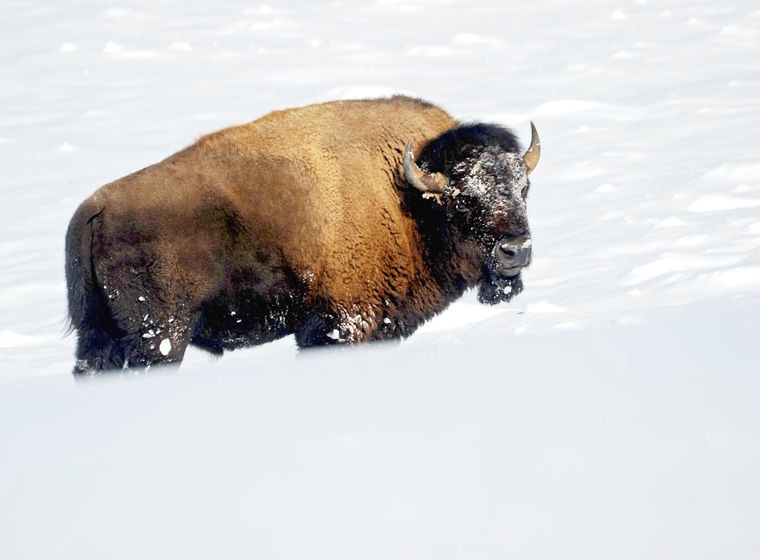Two cases of broken fences and bison walking free from Yellowstone National Park’s bison trap this winter have been a disruption of the status quo.
The first incident, when 52 bull bison escaped through two layers of broken fence in January, erased the possibility that those bison might eventually be transferred to a tribal reservation, which officials say was likely to happen sometime this year.
But the second illegal release of Yellowstone bison, which came sometime late Wednesday night or early Thursday morning, was quickly nullified, as many of the bison returned to the corrals and park staff captured hundreds more shortly after the fence was repaired.
Separate criminal investigations into each are ongoing, but the two incidents have raised questions about the security of the Stephens Creek Capture Facility, and the park’s top official said they’re trying to shore it up.
In an interview Friday, Yellowstone Superintendent Dan Wenk declined to offer specific details on the extra measures park officials are taking but said they are providing a higher level of security. He also said it appears they’ll have to do so into the future.
“It has just pointed out to us that we have to put a lot more funding and manpower behind securing that facility and operating that facility,” Wenk said. “And that’s what we’ll do.”
The facility, which consists of several corrals, a squeeze chute and a loading dock for cattle trailers, has been the starting point for the slaughter of bison for two decades. Last year, it became the starting point for an alternative to slaughter, one that could be used to send live bison to tribal or private lands where they can be used to start new conservation herds or join existing ones.
The alternative, quarantine, certifies bison as free of the disease brucellosis, which can cause animals to abort. About half of Yellowstone’s bison are believed to have been exposed to the disease. It’s feared by the livestock industry, and those fears limit where Yellowstone bison are allowed.
Becoming brucellosis free requires bison to live in isolation in a specific kind of corral for a certain amount of time. Once the brucellosis free status is gained, the animals can be moved more freely. They could join conservation bison herds on tribal reservations or on private lands.
In 2016, Yellowstone proposed establishing a quarantine program at the Fort Peck Indian Reservation and held onto some bison to start the program. But legal and political barriers prevented that plan and, last year, Yellowstone upgraded two corrals at Stephens Creek for quarantine. The idea was to send the bison to Fort Peck after gaining disease-free status.
Several months after the upgrades, final approval for the facility has yet to come from state and federal livestock officials. Montana state veterinarian Marty Zaluski said it’s likely to come in the next week.
Even without final approval, the January release of bison killed the nearest possibility of sending bison to Fort Peck. Yellowstone was holding 52 bulls inside the quarantine corrals for eventual transfer to Fort Peck. Despite the lack of final approval, Zaluski said those bulls “were really within about six months of being given a clean bill of health.”
Releasing them was an “irrevocable setback,” Zaluski said, because they’ve now been re-exposed to brucellosis in the eyes of livestock officials. Even if they were recaptured, they couldn’t be considered disease free.
The second release doesn’t have the same bite, but Zaluski is worried it will continue happening.
“My concern is now that it’s been done twice, potentially this is a new front for opposition to this type of conservation effort,” he said.
While many bison advocates support the idea of quarantine, some see it as the unnecessary domestication of wild animals. They also hope for a broader solution to end the slaughter of bison.
But Stephanie Adams, of the National Parks Conservation Association, said the releases “keep us stuck in this cycle of shipping all of the bison to slaughter each winter rather than looking at other alternatives.”
“If these setbacks continue to occur, we’re continuing to reduce the potential that Yellowstone bison could be used for broader conservation,” she said.
A park spokeswoman said Friday that at least 350 bison were in the trap, meaning there’s still a chance for a new cohort this year. Wenk still sees quarantine as part of the future of bison management, and he’s confident that there’s plenty of support for the idea.
“The bottom line is I think most people would like to see bison on a larger landscape,” he said. “Most people would like to see a successful program.”
Robbie Magnan, the bison program manager for the Fort Peck Tribes, said the releases have been disappointing, but it’s far from the only setback their program has faced. Despite the setbacks, he’s still confident they’ll eventually get some bison.
“I know we’re going to get them,” Magnan said. “But when is what I can’t figure out.”



